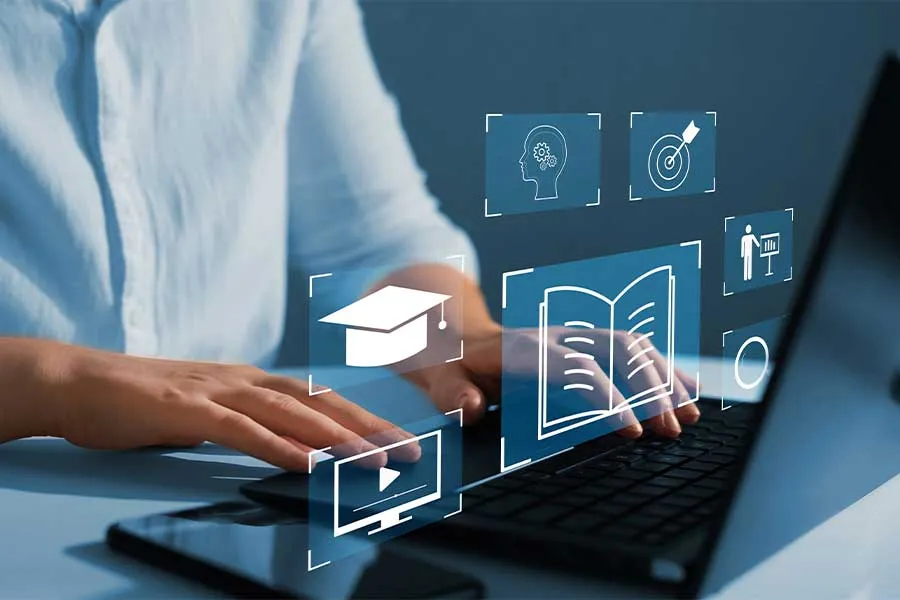Tec de Monterrey’s Institute for the Future of Education (IFE) has presented a report that addresses nine areas where universities can implement digital education (DE) in their models.
The report, Digital Education in Universities: A Comprehensive Implementation Guide, was presented on the last day of IFE Conference 2024.
This guide presents the importance and challenges of implementing digital education in higher education institutions, not only in technological aspects, but also in educational models and other factors such as regulations, financing, and organizational culture.
“We seek to provide one more tool to universities with this report, allowing them to understand the things they need to address in order to successfully implement digital education,” says José Escamilla, Associate Director of the IFE.

Digital education is defined in this document as the use of digital technologies and tools in education.
At the Tec, this model is made up of an entire educational ecosystem that allows for enriching learning experiences, integrating innovative pedagogies with the use of digital media and technologies.
In addition to the different areas it discusses, the report presents success stories from the Tec and other allied institutions that also shared their experience to prepare the document.
CONECTA shares with you the nine areas analyzed in this IFE report for universities to implement digital education:
1. Adopting Digital Education as a strategy
In the document, Beatriz Palacios, the Tec’s Director of Educational Innovation and Digital Learning, explains that digital education should be part of the institution’s strategy, for example, incorporating educational models based on the use of technology at all levels.
It must also identify in which moments and aspects of university life digital education is applied as an element of value for the university community.
The director also refers to seeing technology as a means and not an end in itself. In addition, she suggests having an understanding of areas of opportunity and what you want to solve with technological resources.
The advantages of using digital education include an improvement of teaching and learning, a return on investment in higher education, availability anywhere and anytime, and a reduction of inequalities with access to quality educationfor disadvantaged communities.
2. Defining the plan for the institution’s digital courses
As part of this process, the report indicates that universities need to define what technological skills they seek to develop in their students with the digitalization of classrooms and the integration of technological tools.
It also points out that distance education can be an alternative for students who find it difficult to attend classes or take courses in person.
In addition, it proposes that it is time for educational institutions to plan the implementation of technologies in their syllabuses by understanding the needs of students and taking advantage of digital opportunities to integrate them into programs.
To execute a successful digital plan, the document proposes:
- Define why DE should be incorporated into the institution.
- Know what they want to achieve with the incorporation of DE.
- Specify the human and material resources required to implement DE.
- Prepare teaching staff for the transformation and have a team to support them.
- Align faculty, schools, and technology areas to work together towards the same goal.
- Define the path to follow towards the objective, prioritize the start, and possess what is necessary to reach the final goal.

3. Establishing the pedagogical intent of using technology
In this section, the report points out that the learning objectives and pedagogical intention of using technology need to be taken into account in order to incorporate DE into a traditional educational model.
“We must ask ourselves whether it’s a matter of coverage, scope, quality, relevance, personalization, or equity in determining the best use of technology based on educational intent,” says Juan Pablo Murra, Rector for Higher Education at the Tec, in the document.
Palacios also shares criteria to consider for ensuring digital education is deployed correctly, such as knowing the context around education, creating structures and processes to enable the strategy, having deployment projects, and actively measuring what society needs.
The study also addresses issues and challenges of digitizing an educational institution, such as people’s resistance to change, the financial situation for covering hardware and software costs, the lack of collaboration among internal areas, lack of staff with knowledge about the subject, and even the national context.
4. Following up on implementation and quality assurance
The report indicates that students should be provided with a modern and updated learning environment in accordance with the needs of society and the labor market, as well as harmonizing the human component with current technologies.
It also points out that despite the number of advanced technological trends, it is essential to innovate with reason and responsibility, taking into account how and when to use them to complement students’ learning, such as combining the face-to-face with the digital and with simulated environments and virtual spaces.
Regarding the process of ensuring the quality of DE, the report proposes taking into account several points such as program design, teacher training, implementation and constant support of students and teachers, and evaluation of results to be able to propose adjustments.
It also points out that quality in education refers to students’ capacity for transformation, which will later be reflected in their impact on society.
“We seek to provide one more tool to universities with this report, allowing them to understand the things they need to address in order to successfully implement Digital Education.” - José Escamilla
5. Possessing external standards and accreditations
As well as discussing important aspects for universities adopting digital education in their educational model, the report proposes contemplation of topics that grant them validity to operate officially.
Luis Alberto López, the Tec’s Director of Regulations and Academic Management, mentions in the report that“regulations align and guide us, enabling efforts to be focused towards the same end. Their ultimate goal is academic quality and the validity of programs.”
Two types of regulations are indicated: internal, which establish the guidelines and basis for achieving the institution’s objective; and external, which contemplate what national governments or their accrediting agencies consider correct for ensuring quality of education.
The document shares recommendations on making modifications to regulations when incorporating DE, such as the structure of education plans, evaluation models, accreditation criteria, and consequences of unethical behavior.
It also discusses the advantages and types of accreditation that institutions can have, sharing tips for recognizing which type will favor the institution the most, assessing the cost-benefit for the university, as well as knowing and determining the criteria requested by accrediting agencies.
6. Reviewing technological infrastructure and services
As a guide for universities, the report recommends that physical and digital infrastructure should be considered when implementing a digital education model, both as an important point for execution as well as for attracting students.
In the study, Carles Abarca, Vice President of Digital Transformation at the Tec, points out that there must be a technical configuration authority, a team in charge of making decisions regarding efficiency and security to implement technologies.
He mentions that connectivity is one of the most important aspects, so the type of cloud service adopted is vital. Abarca also remarked that infrastructure must be continuously maintained and monitored.
Moreover, the document mentions three levels for learning digital skills, namely:
- Basic digital relationship skills necessary to function in today’s society.
- Knowledge that applies to roles for managing digital technology.
- Knowledge of researchers, developers, and creators of technological innovation.
7. Establishing investment and financing
The report says it is necessary for institutions to make a significant investment in order to have the infrastructurerequired to implement a Digital Education model, as well as considering training their teachers and keeping them up to date.
Adriana Wong, the Tec’s Director of Student Financial Services and Income, who was formerly the Director of Administration and Finance at the Office of the Rector for Operations, points out that financial issues need to be addressed when the idea is conceived and planned.
In the document, Wong points out that one challenge in the financial area is linked to tools, such as costs in terms of hardware and software acquisition and support, consulting and staff training, and supplies.
She points to the commitment of decision makers and sponsors, budget management, and leadership team priorities as keys to success. It is also important for the business case to be clear about obtaining resources, savings, and allocation of resources.
8. Exploring existing educational technologies
Educational technology, or EdTech, consists of tools that are associated with digital instruments and the Internet that can be implemented as part of the teaching-learning process.
Bertha Saldivar, the Tec’s Director of Technologies for Education, also emphasizes the need to specify the purpose and the most appropriate time to include an educational technology in the curriculum.
The document proposes strategic planning through participating in the design of academic programs in order to suggest the best technology to implement. In other words, technology needs to exist alongside the conception of an educational model and grow along with its design.
The report also recommends evaluating the technologies available in the market and implementing pilot tests with them. In addition, the institution needs to have an area specialized in education technologies.
9. Educating audiences and communicating
As a last area, the report highlights that communication within an organization is key to developing and transmitting the digital education processes that are executed.
Norma Lara, Director of Dissemination and Content in Educational Innovation and Digital Learning at the Tec, mentions that organic deployment of messages requires dissemination strategies that are clear about what is being done, why, what for, and to whom the information is directed.
The director points out that each university determines its goals according to the innovation it hopes to implement and, from that point, prepares its organizational change, taking into account the implied effects and the impact on the university culture.
In the report, Lara shares the following steps:
- Establish a frame of reference of the main actions and key messages for the audiences.
- Identify and communicate the factors of change, raising awareness and making visible the direction of the institutional culture.
- Define the key audiences and groups that will trigger the changes and multiply them when adopting them.
- As enablers for new initiatives, establish motivations and empowerment to transform schemes and offer facilities for change.
To learn more about these nine areas, you can download the full report here.
Speakers on panel about digital education challenges for universities
A keynote panel on challenges and opportunities for universities in implementing digital education was also held for the official launch of this report at IFE Conference 2024.
Participating in this discussion were José Escamilla and Beatriz Palacios, representing the Tec; Alejandro Caballero, education specialist at the International Finance Corporation of the World Bank Group; and Arturo Cherbowski, Executive Director of Santander Universities.
Cherbowski, who also served as moderator, highlighted the publication of the document, part of IFE’s Insight Reportsto inform decision-makers about relevant issues, in this case as a comprehensive implementation guide on DE.
“We need to understand that in its essence, education isn’t different when we include technology. Our first barrier when implementing DE is that we want to think and talk about something that’s different,” says Palacios.
She also pointed out that it is necessary to accelerate the digital transformation of universities and for them to advance in step with new technologies.
For his part, Caballero said that students are digital natives who seek the same digital experiences in their interaction with universities that they have in other areas of their lives, such as entertainment, work, or services.
“DE also opens up a great opportunity for universities to be inclusive, to transcend geographical barriers, to reach remote areas, and to diversify in a world where demographic change is already a reality,” says Caballero.
When talking about establishing a DE model, Escamilla said that it is not similar to what was known as “emergency remote teaching” during the pandemic since it is not about transferring a class to videoconferencing platforms, but proposing a holistic and systematized model, creating a flexible learning environment.
“Universities that do not integrate technology, that do not transform digitally, have little chance of survival in the future,” says Escamilla.
ALSO READ:





